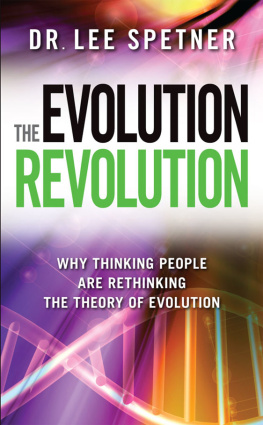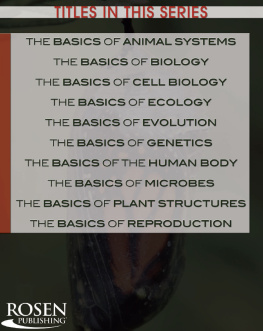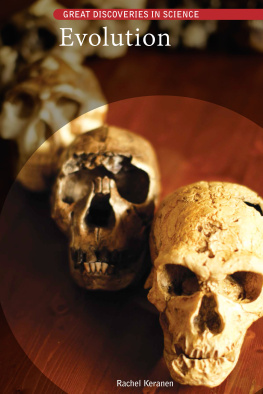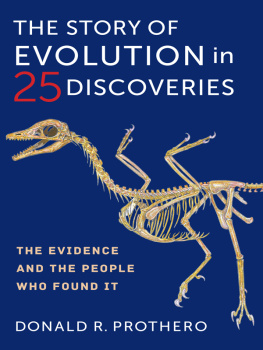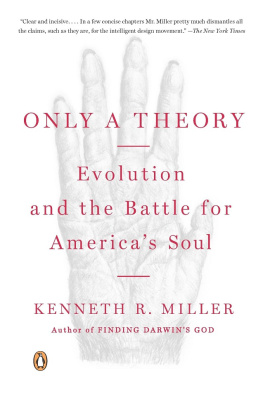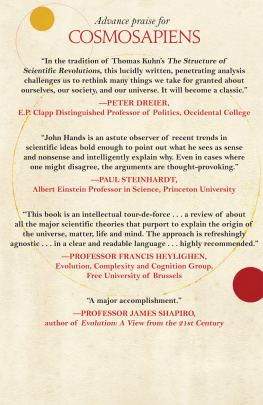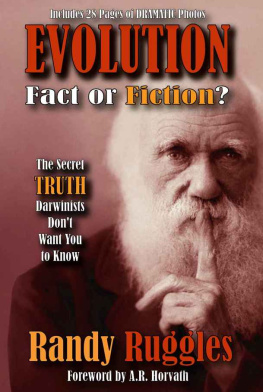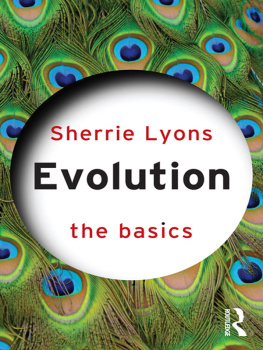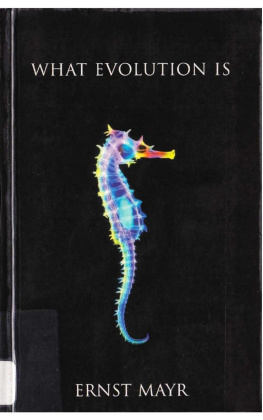
THE EVOLUTION REVOLUTION
Why thinking people are rethinking the theory of evolution
2014 Dr. Lee M. Spetner
All rights reserved. No part of this publication may be translated, reproduced, stored in a retrieval system, or transmitted in any form or by any means, electronic, mechanical, photocopying, recording, or otherwise, without permission in writing from the publisher.
ISBN: 978-1-60763-176-7 (ebook)
978-1-60763-155-2 (hardcover)
Also by this author:
Not By Chance! Shattering the Modern Theory of Evolution
Editor: Nachum Shapiro
Proofreader: Hadassa Goldsmith
Cover design and layout: Justine Elliott
Internal design and layout: Nachum Shapiro
The Judaica Press, Inc.
123 Ditmas Avenue / Brooklyn, NY 11218
718-972-6200 / 800-972-6201
www.judaicapress.com
Manufactured in the United States of America
To Julie, of blessed memory, with whom I shared a wonderful lifetime

Contents
I N 1963, AS I WAS LISTENING TO A LECTURE ON EVOLUTION BY Bentley Glass at Johns Hopkins University, I wondered how all the information in those plants and animals could have been built up. I had been teaching statistical communication theory and information theory at the time, which is probably why this problem occurred to me. I asked Bentley about it a few days after the lecture, but he couldnt help me. He had never thought about my problem. My curiosity about this issue continued and eventually led to my publishing a few papers on the subject, in The Journal of Theoretical Biology (which was a rather new journal at that time), in Nature, and in Transactions on Information Theory of the IEEE. But my ideas on the subject had not yet matured.
I continued to feel that there was something not right about the theory of evolution. I later read Richard Dawkinss book The Blind Watchmaker, and I felt it didnt make sense. Random errors in copying the DNA and natural selection were supposed to account for the evolution of all life from some simple primitive cell. I could not understand how random mutations and natural selection could account for the information buildup in what is called Common Descent. Could those DNA copying errors really bring new information into living organisms? I decided I had to set straight a lot of things about evolution that Dawkins wrote. As a result, I wrote my book Not By Chance!, first published in 1996 in Israel and then in 1997 in the United States.
Neo-Darwinian Theory (NDT) is counterintuitive, and is acknowledged as such even by its supporters. All present-day life is assumed to have evolved from some primitive cell, and that cell was supposed to have formed itself from simple chemicals. Nobody seems to know how that cell came to be, but almost all biologists think they understand fairly well how evolution proceeded from that cell to all the life we see today.
There appears to be a vast amount of information contained in trees, fish, elephants, and people. Where did this information come from? It is said to have come from random mutations and natural selection. How can that work? Natural selection is supposed to be the magic that makes evolution happen, but all natural selection does is eliminate the less adaptive organisms and allow the more adaptive ones to survive and proliferate. Where do those more adaptive ones come from? Apparently, thats what random mutations are supposed to accomplish.
So the information buildup required by Common Descent can come only from random mutations. That means that the buildup of information is a matter of chance. At each step of the evolutionary process, a mutation has to have occurred that grants the organism an advantage. The big question is: Is that reasonable? To see if it is, some people (including me) have made calculations of the probability of mutations building information.
We really dont have all the data we need to make this calculation. But even if we make some conservative assumptions and give the benefit of all doubts to the Darwinian side, such calculations demonstrate that Common Descent is not reasonable (Spetner 1997). The Darwinists, however, do not accept these calculations as conclusive they suggest alternative scenarios that might make the probabilities larger.
In his book Darwins Black Box, Michael Behe addressed the unreasonableness of Darwinian evolution. He described some biological systems as what he called irreducibly complex. By that he meant that these systems are composed of several critical components in such a way that the system cannot work unless all those components are in place. He then argued that the system could not evolve one small part at a time, because natural selection could not work on less than the whole system. Here, too, the Darwinians countered by suggesting scenarios in which natural selection might work, but again, the Darwinian scenarios are purely hypothetical.
Because the Darwinians can invent scenarios to address any challenge to their theory, they are not convinced by attempts to show that neo-Darwinian evolution cannot work. Therefore, I have concluded that it would be more productive to challenge them to show that it could work challenge them to do more than just offer vague scenarios of how their theory might work, but to show by calculation that the probability of it working is reasonably high. This is a challenge they must meet to establish their theory on a scientific basis. They have never met this challenge and they cannot. They cannot show that the events they claim to have produced Common Descent have a high enough probability to justify their claim. Their inability to establish the theory of Common Descent means that Common Descent is not an established theory. This is one of the main points of this book.
I cannot overemphasize the importance of probability calculations. NDT is not like Newtons theory of mechanics, whose equations describe the motion of a physical body under a force. Nor is it like Maxwells theory of electromagnetism, whose equations describe the effects of electric and magnetic fields on electric charges. These theories are checked against experiment by solving those equations. NDT describes evolution as the result of random mutations that may or may not yield an adaptive phenotype. These are chance events. The theory can be checked only by calculating the probabilities of the required events to see if they are reasonably large. The theory has not been shown to have passed this test and is therefore not a valid theory. Whatever evidence is given for Common Descent is circumstantial. Circumstantial evidence cannot stand alone. It needs to have a theory tying the evidence to the conclusion. But instead of a theory, imaginary scenarios are offered to suggest how evolution might work. No calculations of probabilities are made.
The fossil evidence for evolution consists of examples of extinct organisms that are assembled into an order showing a transition from one form to another. That evidence, however, is a long way from a convincing case for evolution. Because these organisms are extinct, there is no way to show what is actually claimed namely, that the transitions were effected by a long sequence of small changes. The theory claims, for example, that some ape-like creature, because of a mutation in a sex cell, gave birth to a slightly more human form. Then one of that creatures descendants did the same, and so on. This chain continued for a few million years until finally a full human was born. This sequence has not been observed, yet that is the claim of Common Descent. Real evidence of Common Descent is nonexistent. I deal with this in Chapter 4.
Next page
